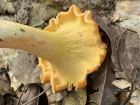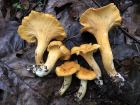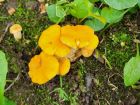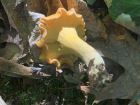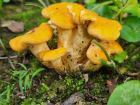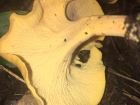Cap planoconvex to flat when young, with a surface that is dry and slightly tomentose, covered with fine hairs. It becomes shallowly vase-shaped or somewhat funnel-shaped as it matures, with an incurved, wavy and irregular margin that typically curves downward in young specimens. The colour ranges from deep, bright orange-yellow to egg-yolk yellow, often fading to a more yellow tone in older specimens. The margins are usually a paler yellow. The underside runs down the stem and is typically smooth or features shallow wrinkles, though it can occasionally develop more pronounced wrinkles that resemble veins, particularly near the margin. Its colour is similar to that of the cap but usually paler. Flesh White and unchanging when sliced. Stem rather plump and stout, more or less cylindrical, and tapers downwards towards the base, which is sometimes white. Internally, the stems are either stuffed with cotton-like mycelia or solid. Occasionally, fruiting bodies may appear clumped together with stems joined at the base, typically in groups of no more than three. The flesh is solid to partly hollow, sometimes due to insect larvae, and has a pale yellow colour. Spore print pale pinkish yellow.
Microscopic Features: Spores measure 6.5 to 9 by 4 to 5.5 micrometres and are ellipsoid to broadly ellipsoid in shape. They have a smooth surface and are inamyloid. In potassium hydroxide, they appear ochraceous. The contents are minutely granular or often contain a single oil droplet.
Cantharellus lateritius on the MushroomExpert.Com Web site.
The second photo is by billyd and licensed under the Creative Commons Attribution-ShareAlike 3.0 Unported license.
Many mushrooms are poisonous, and some can be lethally toxic. Distinguishing between edible and poisonous mushrooms can be very challenging. Therefore, we strongly advise against consuming wild mushrooms. This website does not contain any information about the edibility or toxicity of mushrooms.
Although efforts have been made to ensure accuracy on this website, the information may contain errors and omissions. Therefore, all content provided is for educational and informational purposes only and should not be relied upon or used as a basis for consuming any plants or mushrooms.
External links are provided for reference only. We do not endorse or take responsibility for the content, advice, or products found on these sites or in any advertisements shown on this website.
